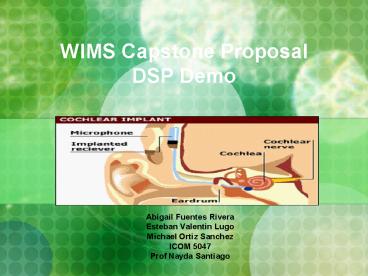WIMS Capstone Proposal DSP Demo PowerPoint PPT Presentation
1 / 26
Title: WIMS Capstone Proposal DSP Demo
1
WIMS Capstone ProposalDSP Demo
- Abigail Fuentes Rivera
- Esteban Valentin Lugo
- Michael Ortiz Sanchez
- ICOM 5047
- Prof Nayda Santiago
2
Outline
- Amarillo-Esteban
- Verde Michael
- Rojo Abigail
- Introduction
- WIMS Background
- Work Done
- Purpose
- Goals
- WIMS DSP
- CIS Algorithm
- DSP Demo
- 8051 Microcontroller
- Plan of Work
- UART
- ADC
- SPI
- Time Schedule
- Team Members
- Facilities and Equipment
3
Introduction
- WIMS ERC
- Universities UMICH, MSU and MTU
- Formed the WIMS ERC
- Merge
- Micropower circuits
- Wireless interfaces
- Biomedical and environmental sensors.
4
Introduction (Cont.)
- Cochlear Implant
- Medical Devices that bypass damaged structures in
the human ear. - Stimulate directly the auditory nerve to allow
deaf individuals to hear and interpret sounds. - Allows simple insertion,
- Stimulates Auditory Nerve
5
Problem and Solution
- WIMS integrates DSP in its structure, providing
low power consumption. - The microcontroller board was found to have
defects. - We offer the WIMS developers a DSP emulator for
further testing
6
Goals
- Implement an emulator for the WIMS Cochlear
Implant DSP. - Learn how to use and configure 8051
Microcontroller. - Use 8051 Microcontroller for the simulation.
7
WIMS DSP
- A DSP is a specialized microprocessor designed
specifically for digital signal processing. - WIMS DSP is a fully integrated, low power DSP
core that performs the Continuous Interleaved
Sampling also known as CIS algorithm. The main
reason for using this kind of integration is the
reduced power consumption and space requirements
of the system. - WIMS DSP receives data from the ADC, filters this
signal, and processes it using values in the LUT,
sending a calculated signal containing the
amplitude and channel thru the SPI to the Hybrid
Chip creating the stimuli to the electrodes
implanted in the cochlea.
8
WIMS DSP Architecture
9
Continuous Interleaved Sampling CIS Algorithm
- Signals from microphone go thru a high pass
filter, then thru n channels by n band pass
filters, where n is the number of electrodes to
be simulated. - Each channel has envelope detection with low pass
filter and rectifier. - Signal is compressed reducing its dynamic range.
- Volume controlled by the patient.
- Output of each channel stimulate the electrodes.
- By stimulating one electrode at the time a better
speech spectrum and speech understanding is
achieved.
10
Continuos Interleaved Sampling CIS Algorithm
11
CIS Algorithm Formulas
- Equations used for the sound filtering.
12
8051 Microcontroller
- The 8051 has 128k for flash memory, which is more
than WIMSs - The 8051 has separate ADC.
- The 8051 microcontroller has low power
consumption, just like the WIMS microcontroller.
13
WIMS DSP EMULATOR
- DSP must be initialized
- ADC receives analog input.
- 16-bit command word generated .
- Command word sent to Hybrid Chip Lab VIEW
interface to simulate electrode stimulation.
14
UART
- Create Interface between Lab VIEW and
microcontroller through UART. - Implement BUFFER to receive data from Lab VIEW,
store in memory.
15
UART
- Universal Asynchronous Receiver/Transmitter
Serial port of the 8051 Microcontroller. - The 8051 does not have a serial output buffer.
- We need to be sure that a character is completely
transmitted before transmitting the next
character.
16
Analog to Digital Converter
- An analog signal will be received from the Data
Acquisition Board, through the ADC. And converted
to a digital Values - The converted data along with the value data
received through the UART will be converted using
the CIS algorithm into a command word. - Data will be sent to SPI.
17
Serial Peripheral Interface (SPI)
- SPI is a serial bus standard established by
Motorola and supported in silicon products from
various manufacturers. - It is a synchronous serial data link that
operates in full duplex, this means, signals
carrying data go in both directions
simultaneously. - SPI is a standard for controlling almost any
digital electronics that accepts a clocked serial
stream of bits.
18
SPI
- The SPI will communicate our 8051 Micro with our
Lab VIEW Interface. - We will send data thru the SPI which will be used
by the Hybrid Chip. - To ensure the success of data transmission, an
acknowledgement signal is received from the Lab
VIEW interface.
19
Time Schedule
20
Team Members
- Engineering students
- Knowledge of microcontrollers, hardware, and
software.
21
Facilities and Equipment
22
Risks
23
Budget
24
Acknowledgements
- Luis Calderon
- Nayda Santiago
- Debbie Ruperto
25
References
- Craig Steinger-Online 8051/8052 Microcontroller
Tutorial Architecture, Assembly Language, and
Hardware Interfacing. - Progress Reports from last semester.
- A DSP Architecture for Cochlear Implants Eric D.
Marsman - 8051 Data sheets
26
Questions and/or Comments?

